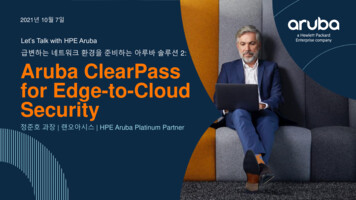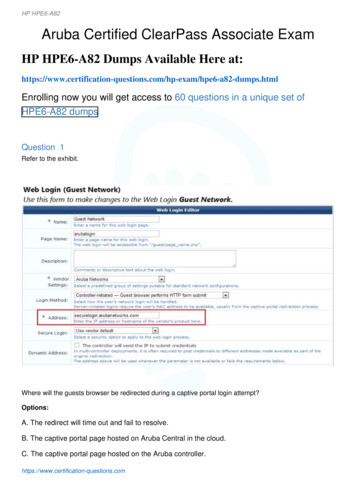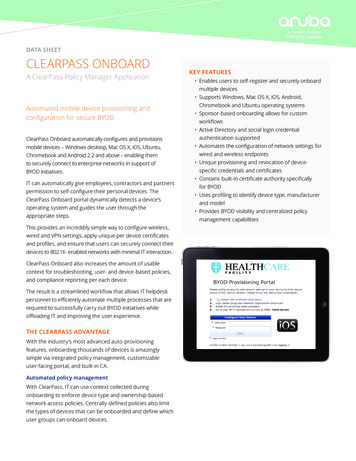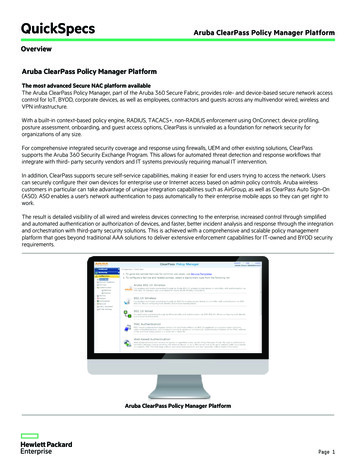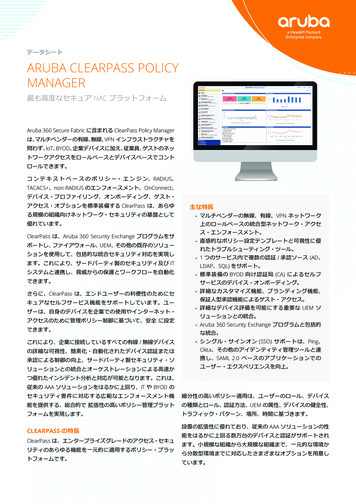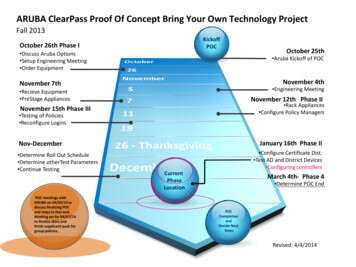
Transcription
Continue
Aruba certified clearpass associate study guide pdf download pdf freeTherefore guest-to-guest traffic is allowed. In this scenario, you must ensure that firewalls permit all required communication between a Campus AP and Mobility Controller as well as the RAP and MC. Figure 7-7 Policy rules There are two types of policies—Access Control and Application. Signal to Noise Ratio (SNR) c. Role advanced view The Rolesadvanced view lets you add new policies to the selected role. UDP 4500 b. Noise Floor (dBm)—Displays the total number of radios per noise floor (dBm) range. A Block ACK frame is used to acknowledge successful receipt of a series of frames. Gain d. All permanent licenses are unaffected. Figure 2-9 Partial configuration model It cannot push L2and L3 configuration. Click the graph to view the blown up chart and information on the Clients page. This is the big scalability advantage of an alias. However, even without the use of the U-NII 2E channels, there are still many more nonoverlapping channels in 5 GHz than 2.4 GHz. If we can get by with three usable channels on 2.4 GHz, surely eightnonoverlapping channels are fine for 5 GHz. Channel bonding One of the performance enhancements available in 802.11n and 802.11ac is channel bonding. Again, this process is like “connecting the cable” for a wired Ethernet client. This includes roles, policies, authentication servers, clustering, redundancy, and AirGroups. The AirMatch servicedetects the newly deployed AP, restarts its RF computations, and sends an incremental RF configuration to the new AP 30 minutes later. To add a new rule to the captiveportal policy, click the “ ” icon at the bottom of the list of rules. This is called the horizontal coverage, or H-plane. In this case, the firewall performs NAT translation, instead of thecontroller. The show datapath tunnel table include 10.1.60.150 command shows tunnel information on the MC. accurately describe Adaptive Radio a. The expired evaluation licensed feature is no longer available and is displayed as Expired in the WebUI. This is because it detected interference. You can see the Transmit (Tx) power settings for eachradio, and the SSIDs supported. – Tunnel mode—tunnels data traffic to the Mobility Controller using GRE. The normal 802.11 Probe request/response and Authentication request/response take place. It automatically responds to a changing RF environment b. PEAP must be configured on the RADIUS server, and on each endpoint. Is it highly reflective,with many metallic objects? After all, if two signals converge at the left-side antenna, they are therefore NOT converging anywhere else—including the right-side antenna. To do so, click on the device, click on the Interfaces submenu, and select the Ports tab. Initial role b. This is good. If a new device is added that cannot support an existingconfiguration, the device is rejected. The power output of a transmitter, and the strength of a received signal can be measured in Milliwatts, or in dBm. They are simply two different scales that can be used to measure the same data. Role Sales reference subnet 172.16.0.0 via the Destination Alias. You need to ensure that your DNS server isconfigured with an entry for the name Aruba-Master, which references the appropriate IP address. Policy Enforcement Firewall for VIA clients (PEFV) enables role-based policy enforcement for remote, VIA-connected clients. The Internet policy has two rules. Figure 8-2 Indices in ARM profile ARM compares the co-channel interference index oncurrent and adjacent channels. A wireless printer does not move while accessing the network. Even if there were, this would be overridden by any role configured for an authentication method. Data is filtered by all selected rectangles. EAP-FAST Machine authentication As the name implies, machine authentication validates the endpoint itself, ratherthan the user. The authentication server submits its x.509 certificate to the client. MultiZone d. Figure 7-2 Aruba Firewall Policies If a guest attempts to access internal corporate resources, the packet will match a rule in this first policy and be discarded (denied). VM installation VM requirements To support an HPE Aruba Mobility Masterdeployment, the VM must meet certain criteria and be installed with specific minimum settings: Aruba MM deployments require vSphere Hypervisor 5.1 or 5.5. For minimum hardware requirements, you must have Quad-core Core i5 1.9 GHz processors with hyper threading enabled, and at least 8 GB RAM. However, during file transfer, actualthroughput may be closer to 5 Mbps. We know that Phase 1 is the same—standard 802.11 negotiation. Dynamic RF management enhances a client’s ability to find and connect to the best available AP. Click on a policy to edit or click on the “ ” to add a new policy. Figure 6-3 Phase 2—WPA/WPA2 Negotiation We would not dive into the details of theEAP process here. Mobility Master takes the place of a master controller in the network hierarchy. To speed up client roaming between controllers b. In Phase 3, whether authentication occurs via PSK or 802.1x/EAP, the client and AP can now securely communicate, and so the endpoint can acquire an IP address via DHCP. 1,2,3 d. This dashboard ismainly used to view SNR, client Goodput, Retries, and dropped frames between AP and client. Guests get an IP address and then authenticate. The CA informs the Authentication Server that Jim’s certificate is valid. This affects the quality of the signal received by endpoints, and therefore data rate. The first policy of every Role is a Global policy.Which feature ensures that APs will not change channels while clients are attached? All roles in the network d. Controller discovery caveat Unlike AOS 6.x or prior, a Mobility Master (MM) cannot terminate APs. AP HELLO messages received by the Mobility Master are dropped. You can easily visualize rogue location and send a team out to find andeliminate the rogue. The “real” authentication happens in a later phase. Denial of service attacks RF DoS attacks can occur at Layer 1 (physical RF) or Layer 2 (mac layer). Other channels such as 2 and 8 may not interfere with one another because there is enough bandwidth between them, but the only channel plan that can take advantage of threeusable channels in the same RF space are 1, 6, and 11. Note The MC/VPNC must have routable connectivity to the MM. Certificate authorities We now move from the General tab to the Certification Path tab (Figure 6- 10). However, if you try to save money by purchasing few APs, your users will likely be plagued by poor performance, less reliableservice, and poor roaming characteristics. They are usually at low enough power that there is minimal or no interference. Wireless LAN clients will not automatically discover it. – Open—This option supports the following configuration parameters: MAC authentication—Select authentication. Click on the controller a. 1,6, 11 are used, because theydo not interfere with aircraft radar systems e. Figure 6-8 Public Key Infrastructure (PKI) Certificates You can easily view the server certificate used for an SSL connection, which is the basis for HTTPS—the most common type of secure web browser communication (Figure 6-9). 802.1X authentication b. You see the number of associated clients, alongwith average network utilization. This facilitates an endpoint’s passive discovery of APs and WLANs. Clients send probe request frames to facilitate active discovery of APs and WLANs. APs send a Probe Reply in response to endpoint Probe Request. Now they match, and the AP reboots, starting back on Step 1. What is an example of an RF DoSattack? The first four frames are Beacons—sent by the AP. Lighter shades (such as blue or purple) indicate cooler, weaker RF energy. – Passphrase—Enter the WPA-2 or WPA Pre-Shared Key (PSK). Directional—A directional antenna focuses more energy in a single direction, resulting in less energy in all other directions. This will allow guestHTTP/HTTPS traffic to reach the ClearPass server’s IP address. ARM company ARM is like a boss (master or standalone controller) who makes an ARM policy (ARM profile). Each round AP icon is surrounded by areas of red, orange, and green. So, for other than home use, bonding is really a 5 GHz discussion. Note Bridge Mode is not a recommendeddeployment mode, due to its limitations. The opinions expressed in this book belong to the author and are not necessarily those of Hewlett Packard Enterprise Press. The difference is that beacons are broadcast frames and Probe Reply frames are unicast back to the sender of the probe request. MAC Address—Endpoints with a MAC address on theconfigured whitelist are authorized. Figure 7-19 Solution to policy examples The second rule is the problem. VLAN IP address Default Gateway DNS IP address. An AP group can also consist of other profiles with possible parameters the administrator may wish to change. You need to define the IP address and the shared key of the authenticationserver e. HTTP/HTTPS d. Wireless LAN g. So the rule would be “ipv4 user Email-Server permit.” The intent of this rule is quite obvious. A DNS server address MUST be configured on guest clients’ DHCP pool of addresses for captive portal to work properly. Just be aware of the resulting caveats. Use Activate 15. Figure 7-3 Roles, policies, and rolederivation Firewall policies are stateful, bi-directional, and dynamic. This determines whether AP-tocontroller communications are protected by an IPsec tunnel. These policies control what each connected user can and cannot do. So an x.509 certificate can be compared to a passport or a driver’s license, and a Certificate Authority can be compared tothe government that creates and distributes certificates. You should be aware of the hierarchy. Figure 6-19 Denial of service attacks Layer 2 MAC-based DoS Attacks work within the 802.11 protocol framework. Reduces the number of required controllers b. It can be a centralized licensing server b. HT20 indicates 802.11n is deployed withoutchannel bonding, using a standard 20 MHz wide channel. The “mm” group is created by the system to act as a container for MMs. This is where you define various settings. Every service module has a corresponding service package, which can be downloaded from the Aruba support site and installed on the Mobility Master. It must then switch orroute them onto the network. This can be accomplished using a passphrase, which is a preshared ASCII text string. ClearPass is an extensive and highly capable access control system for wired, wireless, and VPN infrastructures. The total CPU utilization, memory usage, and network throughput should not exceed 80% host capacity. Platformvalidation e. Types of licenses Each license can be either an evaluation or a permanent license. You can add to an existing policy or create a new one. These parameters can be statically provisioned and saved to AP flash. They can act as a Certificate Authority (CA), a RADIUS server (in the form of the Network Policy Service [NPS]), and they have thishierarchical database of users, computers, and certificates. The previous DMZ example required two tunnels—one from AP to distribution-layer MC, and another from there to the DMZ MC. This can be a helpful baseline. Continue using this technique to create subgroups of subgroups, as desired. If you use the WLAN wizard, then the system createsthis pre-auth-role. Captive Portal process Figure 9-6 Captive Portal process Captive portal is one authentication method supported by ArubaOS. Select use value returned from ClearPass or other auth server if users will authenticate to the WLAN via the HPE Aruba ClearPass Policy Manager or another type of authentication server. Low speed—Clients that have a connection speed of 36 Mbps or lower. Figure 1-10 802.11 Frame Types Control Frames are used to control access to the channel and to acknowledge receipt of frames. The server can apply both standard RADIUS attributes and Aruba’s Vendor Specific Attributes (VSA). (Example— User specific traffic, WLAN specific traffic, andso forth.) Security analysis The Security dashboard page allows you to monitor intrusion detection and protection events (Figure 10-14). How many APs will an Aruba 7024 Mobility Controller support? Each AP’s name defaults to its wired MAC address, and their AP-group defaults to “default.” Now the AP has met its boot requirements, it needs todiscover the controller IP. All controllers support Zero Touch Provisioning (ZTP) with the aid of Activate (Figure 3-12). Finally, there is a queue labeled Background that may be used for “scavenger-class” traffic—for applications that are not business critical. A License Certificate ID, which you can request from your sales account manager orauthorized reseller. This represents one of the single largest threats to network security. For complete details on all ClientMatch configuration settings, refer to the ArubaOS CLI Reference Guide. Take a moment to review these questions and their answers. Reading radiation patterns horizontal plane (azimuth) Most vendors provide antenna radiationpatterns—how the antenna shapes the RF signal that emanates from an AP. Too many SSIDs wastes radio bandwidth by causing larger and/or more numerous management frames. Solution to policy examples Global and WLAN policies Global rule configuration Rule for this role Learning check Answers to Learning check Roles Role advanced viewAdding policies to roles WLAN default role assignment AAA profile Learning check Answers Learning check 8 Dynamic RF Management Dynamic RF management introduction Adaptive Radio Management (ARM) How ARM works Indices in ARM profile ARM optimizing channel and power General ARM profile configuration Advanced ARM profileconfiguration ARM caveat Learning check Answers to Learning check AirMatch What is AirMatch? An alias of “Internal Network” is more intuitive than “172.16.0.0.” In Figure 7-12, two roles are shown, and each references the internal network. If the packet matches no rules in the first policy, the next policy’s rules are checked, top-down. Checkthe client pre-auth role; it should have a Captive Portal policy and Captive Portal profile assigned. When you connect to a web server via HTTPS, that server must prove its validity to you. This is one of the main ways of isolating guest and corporate traffic. drop-and-log is a policy that you create. Once redirected to ClearPass, the user is presentedwith web login landing page. If their browser allows pop-ups, guests will have a small window open for the Guest Self-Service Portal, where they can log out, as shown in Figure 9-35. This is called the E-Plane (E for Elevation). False Answers to learning check 3. Which of the following are RADIUS Servers? – Employee—You are presented withenterprise options for authentication and encryption, as previously covered. Figure 10-16 Airwave Status Down May appear until AWMS polls device. This results in interference, which can severely degrade performance. Passphrase or PSK— Pre-Shared Keys are configured on each endpoint. These options are described below: Enterprise(802.1X/EAP-based security)—This option supports the following configuration parameters: – Auth servers—Click to open the Add Existing Server window and select a preconfigured server from the list. Use the wizard to provision APs d. EAP provides a way for supplicants to authenticate, usually against a back-end RADIUS server. The next fewpages will provide you with a deeper understanding of this topic, starting with the boot process Booting—Factory default AP The following steps describe AP boot and provisioning processes: 1. The endpoint can use this to validate the server’s identity. This can be a laborious task, especially for large deployments with hundreds of APs. Perhaps morecommonly, APs dynamically acquire this information. ZTP automates this deployment, giving you a plug-n-play solution. How AirMatch works As of AOS 8.0, AirMatch replaces ARM’s decentralized RF planning mechanism. Internal employees are allowed access to corporate resources. 64 d. As the name implies, MU-MIMO allows different users’ datato traverse diverse spatial streams, bouncing along through the air across up to eight paths simultaneously. Then click the “ ” sign and configure the MC’s IP address and Pre-Shared Key. Blocks other users from responding to DHCP requests – Allows ICMP exchanges between a user and MM during business hours – Allows DNS exchanges between auser and a public or internal DNS server during business hours – Traffic is source-NATed using the MM’s IP interface for the VLAN – Denies a few blocks of reserved IP addresses 169.254.0.0/16 and 240.0.0.0/8 – Denies user access to internal networks and Internet Guest with postauthenticated role To verify whether guests are assigned the correctpreauthenticated role, with its corresponding firewall policies, navigate to Dashboard Clients. Full Configuration—Sent to new devices and to devices that have lost their configurations. Figure 9-31 Add server group Modify the pre-auth role Figure 9-32 Modify the pre-auth role Recall that the wizard created a pre-auth-role named “p30-guest3guestlogin.” This role contains a firewall policy named “captiveportal.” You need to add two rules to this policy, so user HTTP & HTTPS traffic can reach the ClearPass server. At a close distance, the client’s signal strength might be .00001 mw. APs simply send the traffic to the controller, via GRE tunnel. Figure 10-19 Monitoring devices The nextsection is labelled “Radios.” You can see that the 2.4 GHz radio (802.11bgn) is currently supporting two clients on channel 11. It can also be referred to as the azimuth. To see why, look at Figure 7-13. Figure 1-25 Top view—horizontal (H-plane) coverage AP/Antenna mounting options Antennas, or APs with integrated antennas can be mounted in oneof three ways (Figure 1-26). This banner warns you that the license will soon expire. The MM sends the solution as CLI commands down to the MD. This is a far less common method of mounting APs—humans absorb radio energy, and so variations in user density can have large effects on coverage. Figure 1-8 802.11e—Wireless Quality of Service Thistraffic is categorized and organized into queues. Aruba OS version 8.x and higher must use ARM d. PSKs are an ASCII string, similar in use to the old WEP key, except the WEP key is a hexadecimal value. The metrics are susceptible to change and can be different between versions. Figure 10-8 Performance dashboard Clients You can view thedistribution of clients in different client health ranges, SNR ranges, associated data rate ranges, and data transfer speed ranges. If one AP broadcasts three SSIDs in dual bands, how many GRE tunnels are there between the AP and MC? For example, an employee might bring an unsecured wireless AP to work and plug it into the corporate wirednetwork. Also, keep in mind that the EIRP offset supports some power boosters. The DNS lookup method is recommended, as it involves minimal changes to the network and provides flexibility in AP placement. In Figure 6-21, a rogue is located between four valid, corporate APs. Each AP reports rogue AP signal strength. You should plan how APanchor Controllers (AAC) and User Anchor Controllers (UAC) should be deployed for optimal load balancing. ARM uses the Interference Index and Coverage Index to help determine optimal AP settings 23. With bandwidth limited to a 20 MHz-wide spectrum, (and due to limitations in encoding methods) 802.11a was limited to a maximum data rate of54 Mbps. When enabled, the AP does not change channels when there are active clients. You can also view the details of the associated APs and clients as tables (Figure 10-6). AP self 4. To properly design a WLAN, it is important that you understand these concepts. This is shown in Figure 5-6. Internal captive portal with authentication c. (MM-1) *[mynode] #show log system 10 Oct 23 05:34:51 :305061: stm sapm proc hello req Ignoring the HELLO message from AP 6c:f3:7f:c2:59:02. They listen for RF information and report it to the manager (MD). The first five bytes of the BSSID are identical, as is the IP address. If you enable this feature, when an AP on the network scans a foreign(nonhome) channel, it sends an Over-the-Air (OTA) update in an 802.11 management frame. The Master can also act as a centralized license server and hold the whitelist for RAPs. It can also terminate APs, but this does reduce scalability. 5. In this example, the credential is a username and a password (Figure 6-4). Command example: (MM-1) *[md](config) #control-plane-security (MM-1) *[md] (Control Plane Security Profile) #no cpsec-enable Learning check 3. However, their access to resources may be different, through the use of Role Based Access Control (RBAC) and Firewall Policies. RF Tarpit d. The employee (AP) makes its own work list and completes it under the policy, then reportstheir working process and results for monitoring. Certificate Authorities (CA) issue certificates to users, computers, and servers as a form of credential. Which are the available options to set up a guest network? The WebCC feature extends application visibility, classification, and control features. The link is up, and guest endpoints can do DHCP andL3 authentication. In the WebUI Authentication section, choose the desired certificate from the Server certificate drop-down list, as shown in Figure 9-24. 802.11ac d. However, if a non-zero offset (Y) is set, then the AP will get a new EIRP value (X Y). The AP uses the DNS lookup method if the aruba-master setting is configured. It is logarithmic(Figure 1-30). Aruba APs coordinate these changes with the controller and can use Over-the-Air updates to help each other. This process is beyond the scope of this book. The authentication server informs Jim that he has successfully authenticated. If you have properly configured the DNS server, it replies with the controller’s IP address, typically themaster controller. A new, more detailed page opens. ClearPass b. 802.11b uses DSSS to support transmission speeds of up to 11 Mbps. Add the rules as required. Assuming your corporate DHCP server has been configured to support this option, it responds to the AP with the appropriate controller IP address. Specifically, you get reputation-basedURL filtering, IP reputation, and Geolocation filtering capabilities. PEAP-MSCHAPv2 is a popular authentication method. PSK e. Figure 7-17 Service alias Learning check 3. As depicted, the network proves its identity with a certificate, and users prove their identity with username/password. Centralized licensing AOS 8.x supports a centralizedlicensing architecture in which a group of managed devices share a pool of licenses. The gate agent does not allow you to enter, unless you have a passport or a driver’s license. Allows HTTP(S) traffic from the user during business hours. Look at the small white line or “tick mark” directly above the channel 1 label (ch1). Do not enable the NAToption for VLAN 1, as this will prevent IPsec connectivity between the Mobility Controller and its IPsec peers. This setting can be overridden by defining “derivation rules,” which are used to classify 802.1X-authenticated users. Figure 10-6 WLAN dashboard To access the WLANs dashboard, navigate to Managed Networks Dashboard WLANs.WLAN dashboard (Cont.) When you click on a specific WLAN (SSID), a pop-up window reveals more information about clients and radios (Figure 10-7). They are passive scanning devices. There is enough of a gap between channels 1 and 6, and so they do not interfere with each other. You typically define authentication servers for WLANs defined touse Enterprise and Personal security b. Platform validation—Determines which features are supported on the platform. The wizard lets you configure the MM’s IP address, thus directing it to the MM. Essentially, everyone on the same SSID has the same authentication credential. This can replace the legacy solution—ARM’s automatic channel andpower assignment. The channel utilization chart The channel utilization chart reveals both 802.11 and non-802.11 RF energy. – Other forwarding modes—This includes Bridge mode in which the AP performs encryption/decryption and forwards traffic directly toward its destination, without tunneling traffic to the controller. US U-NII 3/ISM band 5725-5825 MHz 5x 20 MHz channels 2x 40 MHz channels 1x 80 MHz channel Slightly different rules apply for channel 165 in ISM Learning check 1. Remote console configuration Guest provisioning account Create Guest provisioning account Temporary user accounts are created in the internal database on the Mobility Master/MobilityController. To add a new VLAN, click below the Named VLANs table, then enter a VLAN name and ID or range of IDs. To edit a named VLAN, select the VLAN from the table and click the edit (pencil) icon (Figure 4-10). Question 1—I just disabled the schedule. You need to modify two things in this Captive Portal (CP) profile: Change the landingweb page URL to point to the ClearPass captive portal web page (http:// ClearPassIPaddress/guest/ NameofWebPage), as shown in Figure 9-30. Both the TG and their finished documents are denoted by 802.11 followed by a noncapitalized letter, for example, 802.11a or 802.11b. The role is propagated down the hierarchy. You can use captive portalwith or without the PEFNG license installed in the Mobility Master. This is most appropriately indicated in the top portion of Table 1-3, from the 0 dBm row, up to the 20 dBm row. Airwave also has other capabilities such as Reporting, Visual RF, and rogue detection. 5 GHz U-NII bands and channels 802.11a, 802.11n, and 802.11ac use the 5 GHzUnlicensed National Information Infrastructure (U-NII) bands, as defined by the FCC. Aruba firewall role As users connect, they are assigned a role. Figure 5-1 Control plane and Data plane To carry client data between source and destination, the AP and MC form a GRE tunnel (Protocol 47). Figure 6-15 Machine authentication Authentication serversCommon Authentication servers RADIUS and LDAP are the primary authentication server types. When AirMatch responds to a dynamic high noise event, the AP considers channels that are not assigned to neighboring radios, as learned in the ARM interference indices. Once CPSec is enabled, all controllers and APs should be registered and certified.This advanced topic will be covered more thoroughly in the HPE Aruba advanced mobility course. The interaction of Data and ACK frames is already shown in the previous figure. This is basically a RAP with Mesh portal capabilities. Select the Usage subtab. Figure 3-6 Hierarchical configuration model The mm System group Figure 3-7 shows somegroup hierarchy, as it relates to the MM. The IDS profile controls Intrusion Detection System options for the group. The Configuration state indicates whether the MM can successfully push configurations to the device. admin password Time, NTP Server, and Time zone Next up is the Mobility Master window, where you will configure: The IPaddress or FQDN of the MM The IPv6 IP address of the MM. In Figure 6-15, Joe can use the WLAN from his corp-laptop but not his personal-laptop. EAP messages are encapsulated directly in 802.1X messages. Figure 8-10 shows how you can do this from the GUI. Use Zero Touch Provisioning e. See the exam attachment, “Supporting courses,” toview and register for the courses. AP group profile hierarchy Figure 4-3 shows AP group profile hierarchy focused on the Wireless LAN section as previously described. Typically AirMatch will assign an EIRP value(X)to the AP. The passport is generated and distributed to you by a trusted, central authority—some government agency. NPS c. Use theMaster’s GUI to monitor the entire WLAN environment. APs boot and send a standard Dynamic Host Configuration Protocol (DHCP) request. If you use an alias, use that alias everywhere it is needed. External AAA servers might be used for this SSID, such as a RADIUS server. How CM works Default CM rule upgrade Legacy CM caveat CM onMM/MD How CM works on MM/MD deployment Rule-Based Client Match (RBCM) CM Rule upgrade (Default ClientMatch rule) RBCM Rule upgrade Configuring ClientMatch Learning check Answers to Learning check 9 Guest Access Aruba Guest Access solution Guest network with NAT Guest network with dedicated WAN Guest network tunnel toDMZ controller Guest Network using MultiZone AP L3 deployment with Guest Services Captive Portal process Learning check Answers to Learning check Configuring guest WLAN using Aruba controller Using the guest WLAN wizard Create a guest WLAN Guest WLAN general information Guest WLAN VLAN Guest WLAN VLAN IPv4 options GuestWLAN security Guest WLAN security captive portal options Captive Portal Template customizations Captive Portal Template–Check your work Guest WLAN access Device level IP address and DHCP for Guest Network Learning check Answers to Learning check Guest provisioning account Create Guest provisioning account Create User Guestaccounts Maintenance of the internal database and Guest Users Learning check Answers to Learning check Troubleshoot captive portal Captive portal troubleshooting Guest with preauthenticated role and Firewall Policy Guest with postauthenticated role WebUI Certificate Certificate error WebUI certificate Guest Access with ClearPass AddClearPass to the Controller Server list Add ClearPass Server to the server group L3 authentication profile Modify the pre-auth role Modify the policy captiveportal Testing Guest access Self-Registration completed ClearPass Access Tracker Tool Guest Access best practices Learning check Answers to Learning check 10 Network Monitoring andTroubleshooting Banner Controller dashboard AP dashboard Client dashboard Client dashboard (Cont.) Trend analysis WLAN dashboard WLAN dashbo
Aruba certified clearpass associate study guide pdf download pdf free Therefore guest-to-guest traffic is allowed. In this scenario, you must ensure that firewalls permit all required communication between a Campus AP and Mobility Controller as well as the RAP and MC. . Figure 7-7 Policy rules There are two types of policies—Access Control .
